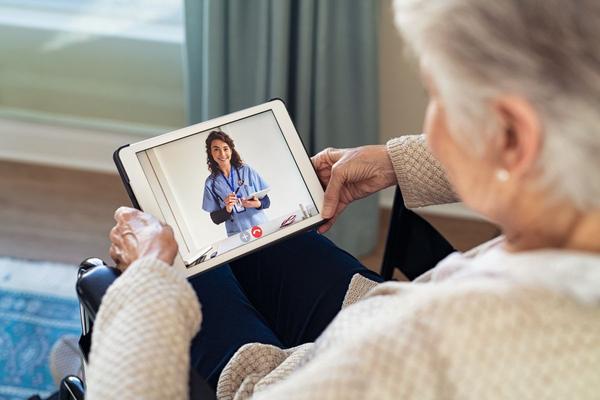BAR HARBOR — While two years of the COVID-19 pandemic has limited options across all areas of life, for medical visits the options have increased. Part of the “new normal” is speaking to your doctor, physician’s assistant or nurse over a computer screen or phone, part of the rise of telehealth services in Hancock County and nearly everywhere else.
Governor Janet Mills signed an emergency law in April of 2020 making it easier for patients to receive and health care facilities to bill for telehealth services. The fact that bipartisan legislation is before state legislators this year to make some of those measures permanent signals that telehealth use will continue at present or higher rates.
Bucksport Regional Health Center (BRHC) sees patients via telehealth for roughly 20 percent of all visits, CEO Carol Carew said, after shifting the majority of visits to telehealth during the pandemic.
Like most facilities, BRHC uses telehealth for current patients who the clinic has seen before at the office or hospital and plans to continue this in the future.
“Telehealth is here to stay,” Carew said. “It is ideal for follow-up visits. Patients love the convenience. Some providers will spend more face-to-face time with the patients on telehealth than in person; patients really like that.”
But having the technology in place in the doctor’s office and patient’s home is critical. At Mount Desert Island Hospital, only 1 to 5 percent of visits are conducted using telehealth, Communications Director Oka Hutchins said.
“Due to technology, reimbursement and adoption challenges, we have not experienced a pronounced shift,” she said. On the patient side, “lack of connectivity and technology challenges are barriers for some of our patients,” she added. The hospital does use telehealth at its Swan’s Island clinic and outer islands, though.
But the Bar Harbor hospital is working on improving telehealth capabilities on its end, including the use of an electronic health records system “that will provide a better platform for telehealth services as they continue to develop,” Hutchins said.

Health care providers tagged behavioral health as a particularly good fit for telehealth services. Currently, over half of Community Health and Counseling Services’ (CHCS) therapy sessions in Ellsworth are delivered via telehealth, CHCS Manager for Hancock County Lori Wilson said. For new therapy patients, an initial in-person visit is not required.
But telehealth therapy is limited for patients in remote areas with poor internet service, she noted. “In some of those cases, we may still be able to deliver services via phone only, but that is not ideal, or always available depending on the insurance coverage the client may have.”
And while some CHCS therapists identify missing information or cues that come from in-person sessions, “on the flip side,” Wilson said, “they appreciate that clients don’t have to wear masks during their telehealth sessions, so providers and clients can see facial expressions and communicate more clearly.”
The quality of care remains equal whether psychological services are held in person or over a screen, Ellsworth-based psychologist Dr. Michael Curless noted.
“Therapy is essentially done in the same manner in-person or via telehealth,” Curless said. “Telehealth treatment can be just as therapeutic as in-person, in my experience.”
He offers both types of visits, with 5 to 10 percent of his patients currently choosing telehealth visits.
However, telehealth also works for chronic care and other conditions and follow-ups.
“Telehealth is fantastic for routine/chronic care visits such as anxiety, depression, medication follow-ups for many chronic conditions and even in some cases diabetes and hypertension management follow-ups,” Northern Light Blue Hill Hospital nurse practitioner Jacqueline Carter said. “Routine counseling/therapy and medication management as well as substance use disorder treatment have all improved access and continuity of care through telehealth.”
The use of telehealth at Northern Light Health has increased 1,200 percent since the pandemic’s start, said Kelley Columber, communications director for Northern Light Maine Coast and Blue Hill hospitals, with 12 percent of all outpatient visits now conducted using telehealth services, and about 6 percent in Ellsworth and Blue Hill.
“Acute care needs, like COVID-19 symptom assessment/management, and mental health services are some of the most frequently used telehealth services,” Columber noted.
“At times both providers and patients express some reluctance before using the tool, but almost universally once someone uses telehealth services, they realize how easy it is to use and that the care they receive is still great,” she said.
However, one area telehealth falls short in is crossing some state lines. While Maine allows residents to access telehealth services outside of Maine, opening up a wider range of care options, not all states do.
Prospect Harbor resident Roger Bowen discovered this when he was diagnosed with cancer and chose to be treated in Boston at Dana-Farber Cancer Institute.
“I made semiannual, then annual trips to be retested and for consultations with my oncologist,” Bowen told the Islander. And, during the 2020 pandemic, he was able to have a CT scan done locally, sent to his oncologist in Boston, and followed up by teleconference.
But Massachusetts recently passed a new law that no longer permits teleconferences with out-of-state patients, he said. So, when he had his latest CT scan done locally and sent to Dana Farber, he received a bad news phone call, saying, “I’m sorry, we have a new telehealth law that went into effect and we’re no longer able to speak by teleconference interstate.”
He had the results sent anyway, Bowen said, and hasn’t heard back.
“I sort of work in the dark now,” he said, reading and interpreting the CT scan himself. “I think the tumor that’s growing in my gut is growing at a slow enough pace I will die before the tumor becomes life-threatening. But I love the hand-holding and assurances that a physician can give me.”




